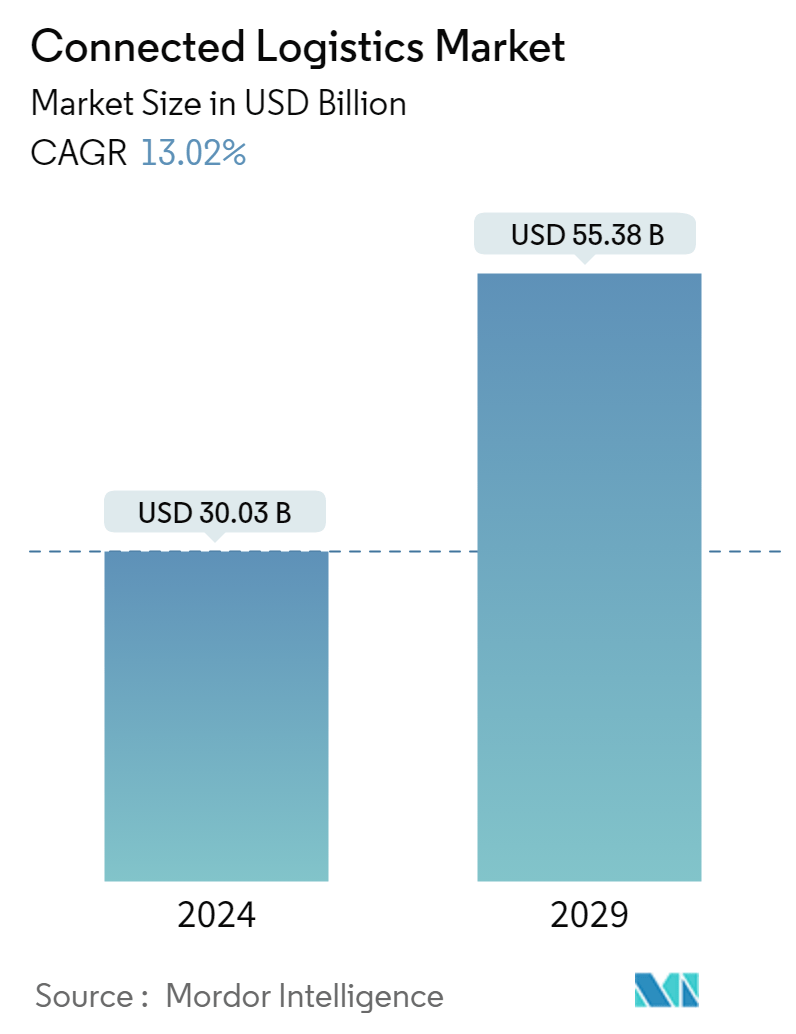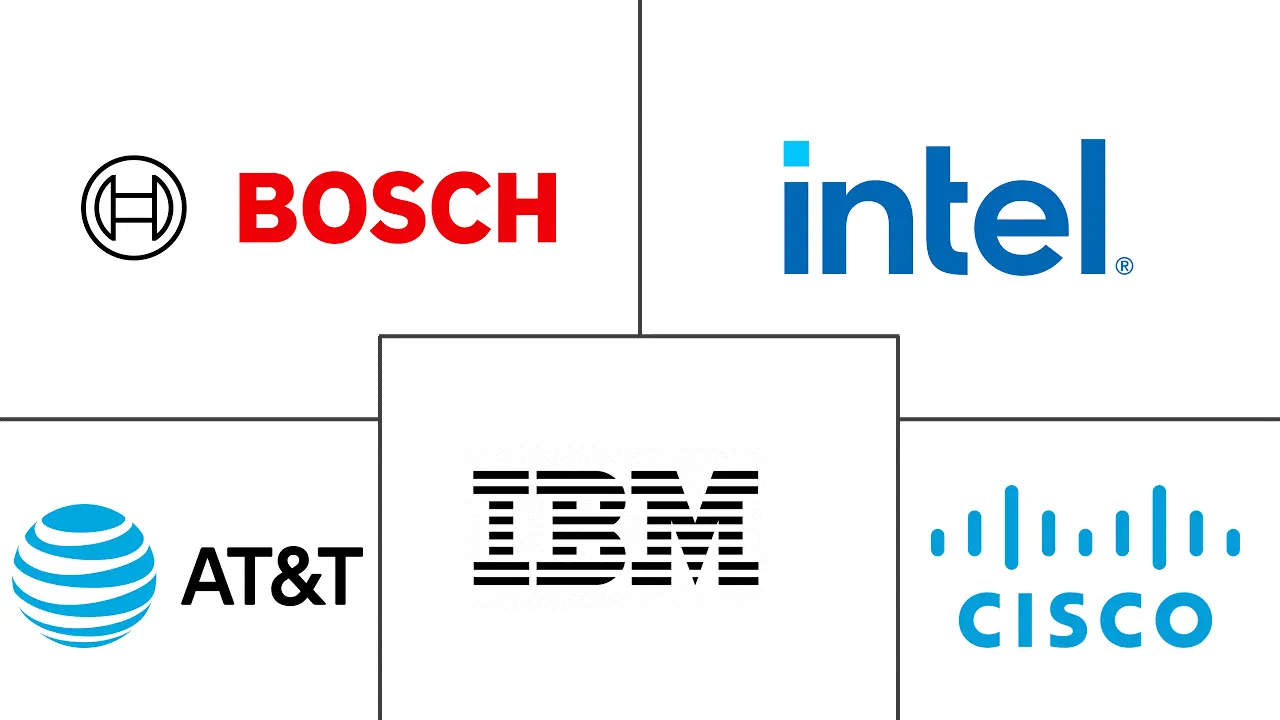| Study Period | 2019 - 2029 |
| Market Size (2024) | USD 30.03 Billion |
| Market Size (2029) | USD 55.38 Billion |
| CAGR (2024 - 2029) | 13.02 % |
| Fastest Growing Market | Asia Pacific |
| Largest Market | North America |
| Market Concentration | Medium |
Major Players*Disclaimer: Major Players sorted in no particular order |
Connected Logistics Market Analysis
The Connected Logistics Market size is estimated at USD 30.03 billion in 2024, and is expected to reach USD 55.38 billion by 2029, growing at a CAGR of 13.02% during the forecast period (2024-2029).
The connected logistics market is undergoing significant transformation, driven by advancements in technology and the growing need for efficient and real-time supply chain management. This sector is characterized by the integration of IoT, digital platforms, and smart logistics solutions that enhance visibility, optimize operations, and provide seamless connectivity across the supply chain. As industries increasingly adopt connected logistics solutions, the demand for cloud-based logistics, fleet management technology, and predictive analytics in logistics continues to rise.
- Integration of IoT in Logistics: IoT in logistics plays a critical role in enhancing supply chain visibility and efficiency. The integration of IoT devices and sensors enables real-time monitoring of assets, including fleet management technology, crucial for logistics network optimization. These technologies provide accurate and timely data, allowing for better decision-making and reducing the risks associated with supply chain disruptions. The adoption of digital logistics platforms is also on the rise, enabling companies to manage their logistics operations more effectively by leveraging cloud-based logistics solutions and predictive analytics in logistics.
- Adoption Across Various Industries: The market is seeing widespread adoption across various industries such as automotive, manufacturing, and healthcare. These industries benefit from connected logistics systems that enable real-time tracking systems, logistics automation, and telematics in logistics, all of which contribute to enhanced operational efficiency. Furthermore, the implementation of smart logistics and connected freight systems is crucial for achieving end-to-end supply chain integration, which is becoming a priority for companies aiming to stay competitive in the global market.
Expanding IoT Adoption Across Industries
The integration of IoT in logistics has become a critical component for enhancing supply chain visibility and efficiency. IoT devices and sensors enable real-time monitoring of assets, including fleet management technology, which is crucial for logistics network optimization. These technologies provide accurate and timely data, allowing for better decision-making and reducing the risks associated with supply chain disruptions.
- Role of Smart Logistics: Smart logistics, powered by IoT, supports logistics automation and warehouse management systems, leading to reduced operational costs and improved productivity. The adoption of digital logistics platforms is also on the rise, enabling companies to manage their logistics operations more effectively by leveraging cloud-based logistics solutions and predictive analytics in logistics. With IoT adoption expanding, industries are better equipped to achieve real-time tracking and connected freight systems, ensuring a more responsive and agile supply chain.
- Importance in Manufacturing Sector: This trend is particularly noticeable in sectors like manufacturing, where the need for logistics network optimization and seamless supply chain visibility is paramount. The integration of IoT and connected logistics solutions allows manufacturers to maintain a competitive edge through improved efficiency and reduced operational costs.
Adoption of Sensor-Based Technologies
Sensor-based technologies play a crucial role in the connected logistics market by enabling precise and real-time tracking systems. These sensors are integrated into various components of the logistics network, from fleet management technology to warehouse management systems, providing continuous data streams that enhance supply chain visibility.
- Enhancing Efficiency with Sensors: The use of sensors in smart logistics facilitates logistics automation, allowing for more efficient operations and reducing human error. This is particularly important in industries such as automotive and healthcare, where precision and reliability are essential. By incorporating sensor-based technologies, companies can achieve greater control over their logistics processes, from asset management to end-to-end supply chain integration.
- Rising Digital Logistics Platforms: Moreover, the rise of digital logistics platforms has been driven by the need for real-time data and analytics, which are made possible by sensor-based technologies. These platforms enable companies to optimize their logistics network, improving overall efficiency and responsiveness. The integration of predictive analytics in logistics, powered by sensor data, allows for proactive decision-making and risk management, further enhancing the effectiveness of connected logistics solutions.
This connected logistics market analysis highlights the transformative impact of IoT and sensor-based technologies on the industry, emphasizing the importance of real-time tracking, logistics automation, and supply chain visibility for achieving competitive advantage in the market.
Connected Logistics Industry Segmentation
Connected Logistics technology, offered by IoT solution providers, enhances operational efficiency in the logistics sector. These technologies streamline fleet management, tracking, asset oversight, and warehouse operations. Beyond these, they encompass order processing, financial transactions, dispatching, and shipping. By fostering communication among all stakeholders, Connected Logistics not only minimizes emissions and environmental impact but also provides real-time updates on transportation and logistics progress.
The scope of the report covers the different types of connected solutions on the basis of product type and software solutions they offer for a wide range of transportation modes and end-user industries. The study also tracks the key market parameters, underlying growth influencers, and major vendors operating in the industry, which supports the market estimations and growth rates over the forecast period. The study further analyzes the overall impact of COVID-19 on the ecosystem.
The connected logistics market is segmented by software (asset management, warehouse IoT, security, data management, network management, streaming analytics), service (professional services, managed service), transportation mode (roadways, railways, airways, seaways), end-user industries (automotive, manufacturing, oil and gas, IT & telecom, healthcare, IT and telecommunication, retail, food and beverage, other end-user industries) and geography (North America [United States, Canada], Europe [Germany, United Kingdom, France, Rest of Europe], Asia-Pacific [India, China, Japan, Rest of Asia-Pacific], and the rest of the World). The market sizes and forecasts are provided in terms of value (USD) for all the above segments.
| Asset Management |
| Warehouse IoT |
| Security |
| Data Management |
| Network Management |
| Streaming Analytics |
| Device Management |
| Application Management |
| Connectivity Management |
| Roadways |
| Railways |
| Airways |
| Seaways |
| Automotive |
| Manufacturing |
| Oil and Gas |
| IT & Telecom |
| Healthcare |
| IT and Telecommunication |
| Retail |
| Food and Beverage |
| Other End-user Industries |
| North America | United States |
| Canada | |
| Europe | United Kingdom |
| Germany | |
| France | |
| Asia | China |
| Japan | |
| India | |
| Australia and New Zealand | |
| Latin America | |
| Middle East and Africa |
Connected Logistics Market Size Summary
The connected logistics market is poised for significant growth, driven by the increasing adoption of IoT and sensor-based technologies such as RFID within supply chain management systems. These advancements are enhancing transparency and efficiency, making businesses more customer-centric. The integration of Big Data and advanced analytics is further propelling the shift towards Logistics 4.0, where data from smart supply chains is transformed into actionable insights through AI systems. This transformation aids in accurate demand forecasting and improved capacity planning. The demand for cloud-based solutions and the ubiquity of the internet are also contributing to market expansion. Additionally, macroeconomic factors like changing consumer lifestyles, emerging economies, and the rapid development of smart cities in countries like China, Brazil, and India are further fueling market growth.
The Asia Pacific region, particularly China and India, is expected to experience robust revenue growth in the connected logistics market. China's dominance in the global e-commerce sector, supported by advanced internet infrastructure and global logistics networks, underscores this trend. Singapore's strategic initiatives, such as the Logistics Industry Transformation Map, aim to enhance logistics operations and attract investment, further bolstering the region's market potential. The competitive landscape is moderately fragmented, with numerous players driving technological advancements and product innovations. Companies like Oracle and E2open are making strategic moves to enhance their cloud-based supply chain solutions, indicating a trend towards increased investment and development in the sector.
Connected Logistics Market Size - Table of Contents
1. MARKET DYNAMICS
-
1.1 Market Drivers
- 1.1.1 Increasing Adoption on IoT in Various Industries
- 1.1.2 Adoption of Sensor Based Technologies
-
1.2 Market Restraints
- 1.2.1 Lack of Uniform Government Regulations for Smart Technologies
- 1.2.2 Coronavirus Outbreak Influencing Electronic Industry
2. MARKET SEGMENTATION
-
2.1 By Software
- 2.1.1 Asset Management
- 2.1.2 Warehouse IoT
- 2.1.3 Security
- 2.1.4 Data Management
- 2.1.5 Network Management
- 2.1.6 Streaming Analytics
-
2.2 By Product Type
- 2.2.1 Device Management
- 2.2.2 Application Management
- 2.2.3 Connectivity Management
-
2.3 By Transportation Mode
- 2.3.1 Roadways
- 2.3.2 Railways
- 2.3.3 Airways
- 2.3.4 Seaways
-
2.4 By End-user Industry
- 2.4.1 Automotive
- 2.4.2 Manufacturing
- 2.4.3 Oil and Gas
- 2.4.4 IT & Telecom
- 2.4.5 Healthcare
- 2.4.6 IT and Telecommunication
- 2.4.7 Retail
- 2.4.8 Food and Beverage
- 2.4.9 Other End-user Industries
-
2.5 By Geography***
- 2.5.1 North America
- 2.5.1.1 United States
- 2.5.1.2 Canada
- 2.5.2 Europe
- 2.5.2.1 United Kingdom
- 2.5.2.2 Germany
- 2.5.2.3 France
- 2.5.3 Asia
- 2.5.3.1 China
- 2.5.3.2 Japan
- 2.5.3.3 India
- 2.5.4 Australia and New Zealand
- 2.5.5 Latin America
- 2.5.6 Middle East and Africa
Connected Logistics Market Research FAQs
How big is the Connected Logistics Market?
The Connected Logistics Market size is expected to reach USD 33.94 billion in 2025 and grow at a CAGR of 13.02% to reach USD 62.59 billion by 2030.
What is the current Connected Logistics Market size?
In 2025, the Connected Logistics Market size is expected to reach USD 33.94 billion.




